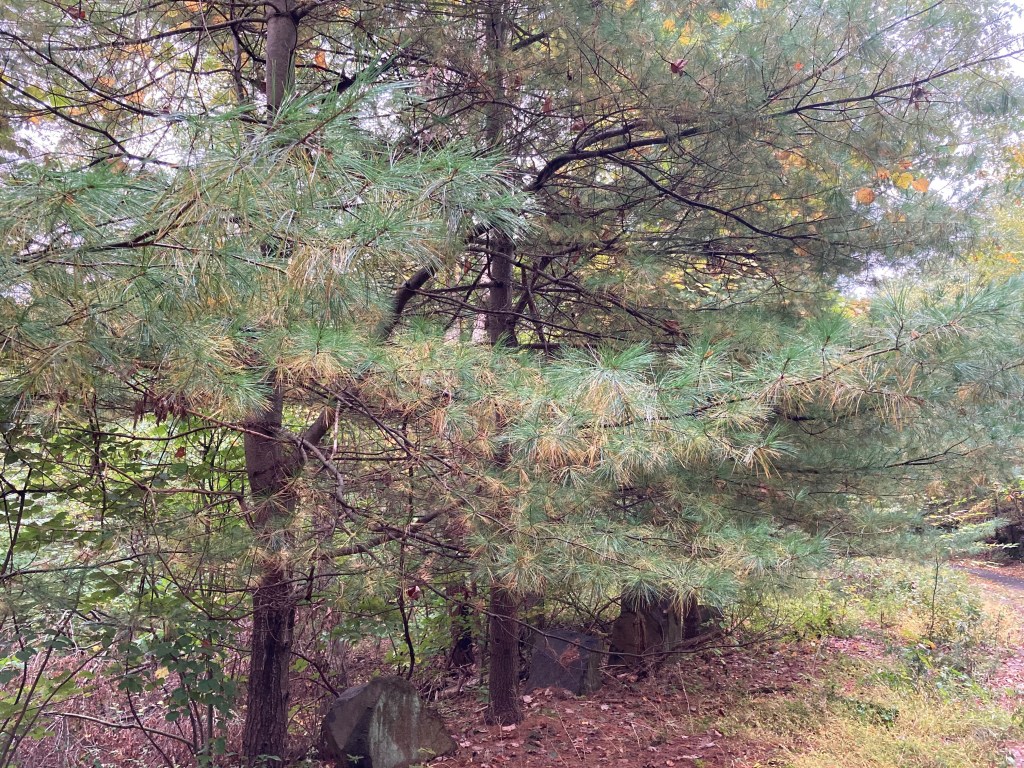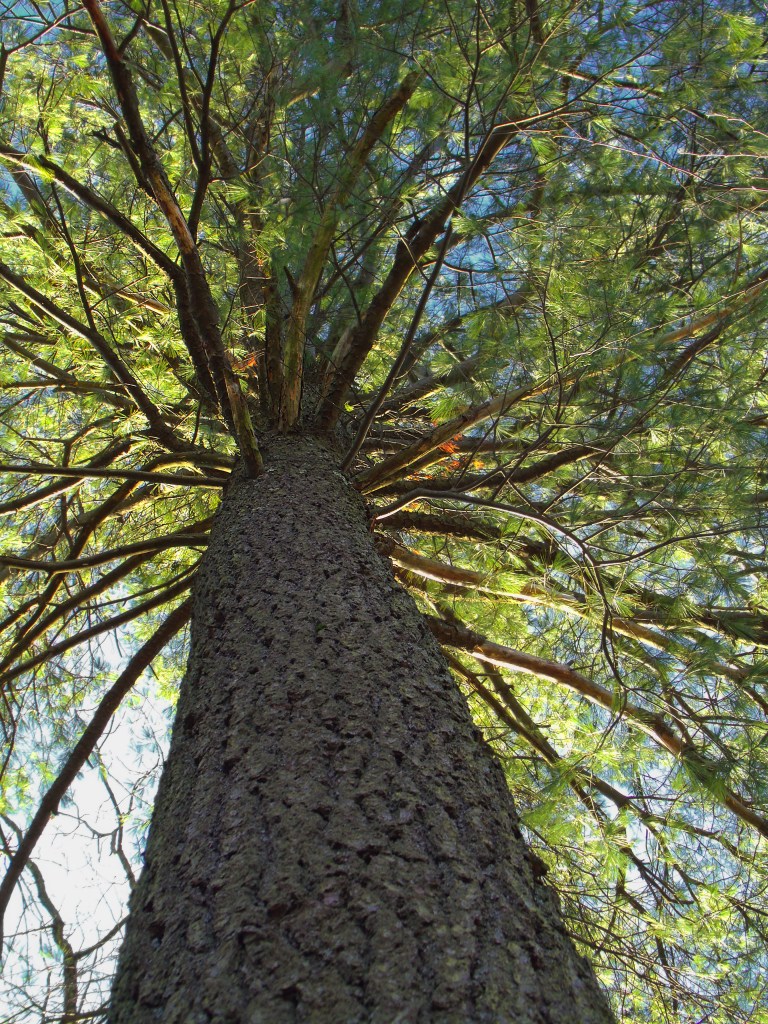As the fall foliage nears its peak of color here in southern New England, I can’t help but notice changes in those “evergreens.” Many trees we call evergreen are not. They actually lose some of their leaves in the fall, or replace them gradually over time. The Eastern White Pine (Pinus strobus) is one of these. Its leaves, or needles, usually last about three years and two winters before they turn yellow and fall off. The older leaves are usually closer to the trunk, and newer, younger growth is found on the outer twigs.

White Pine can be told apart from other native pines by its five leaves per fascicle, or bundle. An easy way to remember this is “five needles per bundle, five letters in the word white.” The flexible, silky needles are usually about 5 inches (13 centimeters) long. From a distance they look full, soft, and “fluffy.” White Pine branches form whorls that arise from the same point, and each whorl represents one year’s growth. So, you can roughly tell the age of the tree by counting the number of whorls.


White Pine is monecious, with male and female flowers on the same tree. Fertilized female flowers become long, easily identifiable cones up to 8 inches (20.32 centimeters) long that hang downward from the tips of branches.

The Haudenosaunee confederacy of northeastern North America chose the White Pine as its “Tree of Peace.” The five leaves symbolize the joining of the five founding nations—Mohawk, Oneida, Onondaga, Cayuga, and Seneca—that made up what the English called the Five Nations Confederacy and the French termed the Iroquois League. The Haudenosaunee confederacy was founded by the Great Peacemaker sometime between 1450 and 1660. Legend has it that its leaders met under a large White Pine.
Early New England colonists encountered very large White Pines. Often these stands of straight, old growth trees towered around 150 feet (45 meters) or more and were over 200 years old. In the 1980s a tree growing near Syracuse, New York, was determined to be 458 years old.

These large trees were perfect for building ships. Their tall, straight trunks were made into masts for the British Royal Navy. The light, strong wood was used for frames and planking. In 1772, Great Britain’s King George III decreed that all trees over 12 inches (30.5 centimeters) in diameter were reserved for his use only. British surveyors marked these trees with the King’s Broad Arrow. Fights broke out between the colonists and surveyors, and the Pine Tree Riot of 1772 was a precursor to the War of Independence. Some colonists flew a flag with a White Pine on it.


I love the sound of the wind blowing through a grove of White Pines. Many describe this as a lonesome sound, often expressed in folk songs as “the cold, lonesome pines” or “the trail of the lonesome pine.” But pines are far from lonesome. They are full of life. According to entomologist Doug Tallamy, White Pine is a larval food plant for more than 230 species of butterflies and moths. Lots of caterpillars mean lots of food for birds like the Black-capped Chickadee (Poecile atricapillus).

The Red-breasted Nuthatch (Sitta canadensis), Pine Warbler (Setophaga pinus), Chipping Sparrow (Spizella passerina), Common Grackle (Quiscalus quiscula), and crossbills (Loxia spp.) all feed on White Pine seeds. This seed is also a food source for the Eastern Chipmunk (Tamias striatus), Eastern Gray Squirrel (Sciurus carolinensis), Red Squirrel (Tamiasciurus hudsonicus), Northern and Southern Flying Squirrels (Glaucomys sabrinus and G. volans), White-footed Mouse (Peromyscus leucopus), and Southern Red-backed Vole (Myodes gapperi).
White Pine’s thick branches provide important winter cover for a variety of birds and mammals. Larger branches are nesting sites for Sharp-shinned Hawk (Accipiter striatus), Cooper’s Hawk (A. cooperi), Northern Goshawk (A. gentilis), Great Horned Owl (Bubo virginianus), and the Common Raven (Corvus corax). Pileated Woodpeckers (Dryocopus pileatus) often excavate their large rectangular nesting cavities in White Pines and search for carpenter ants (Camponotus spp.), their favorite food, within the trunks.
In the landscape, White Pine is best planted away from the house, as limbs weighed down by snow and ice can break rather easily. Although a large tree, it can be planted as a hedge if pruned regularly to control growth. With its wildlife-attracting abilities, lovely form, and year-round greenery, White Pine makes a wonderful specimen tree. One that is not lonesome at all.
As usual I look forward to and love reading your articles.
Maishe
LikeLike
Thx so much Maishe! Means a lot coming from you. All best, Jim
LikeLike
Thank you for for blog. It is always interesting and informative. I think I have shared every one of your blogs with a different friend each time. Jane in West Hartford
On Thu, Oct 14, 2021, 11:53 AM Beyond Your Back Door wrote:
> Jim Sirch posted: ” As the fall foliage nears its peak of color here in > southern New England, I can’t help but notice changes in those > “evergreens.” Many trees we call evergreen are not. They actually lose some > of their leaves in the fall, or replace them gradually over tim” >
LikeLike
Thx so much Jane! You made my day! Best, Jim
LikeLike
Really nice article, Jim. I’ve always been pleased that the White Pine is the Michigan state tree. I love being able to identify it from a distance because of its soft look. I really like all the details that you covered. Thank you. Wiz
LikeLike
Thx Wiz! I know you have a lot of white pines in Michigan! All best, Jim
LikeLike